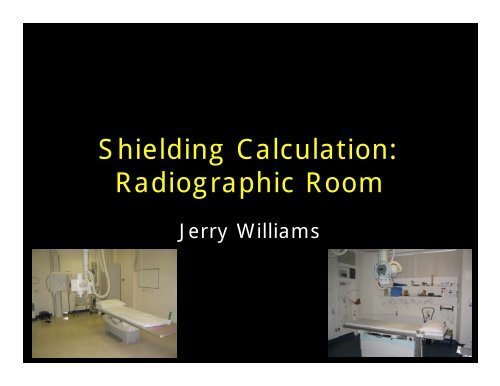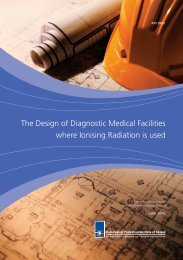Shielding Calculation: Radiographic Room
Shielding Calculation: Radiographic Room
Shielding Calculation: Radiographic Room
Create successful ePaper yourself
Turn your PDF publications into a flip-book with our unique Google optimized e-Paper software.
<strong>Shielding</strong> <strong>Calculation</strong>:<br />
<strong>Radiographic</strong> <strong>Room</strong><br />
Jerry Williams
What you need to know<br />
• <strong>Room</strong> use and layout<br />
– DAP workload<br />
– DAP averaged kV<br />
– Distance to barrier<br />
• Construction details<br />
– Walls<br />
– Ceilings/ floors<br />
• Surrounding areas<br />
– <strong>Room</strong>s above or below<br />
– Occupancy
DAP Workload<br />
Two approaches:<br />
1. Predict clinical usage and use typical<br />
DAP values per exam<br />
2. Assume typical total DAP values
Method 1: DAP data<br />
• UK Dose Surveys<br />
– HPA-RPD-029<br />
– http://www.hpa.org.uk/radiation/<br />
– <strong>Room</strong> doses for 50 – 90 kg patient sub-set set<br />
–Mean<br />
–Min/ max<br />
– 25 th / 50 th / 75 th percentile values<br />
– kV and mAs values<br />
• National Diagnostic Reference Levels<br />
– Based on 3 rd quartile values<br />
– “Boundary between good and normal practice and<br />
bad and abnormal practice”
Radiography doses (1)<br />
Projection<br />
No of<br />
rooms<br />
DAP<br />
Gy cm 2<br />
Skull PA/AP 20 0.78<br />
Skull Lat 19 0.49<br />
Chest PA 210 0.11<br />
Chest AP 12 0.12<br />
Chest Lat 23 0.31<br />
Thoracic spine AP 36 0.93<br />
Thoracic spine Lat 27 1.43<br />
Abdomen AP 127 2.58<br />
Lumbar spine AP 118 160 1.60<br />
Lumbar spine Lat 120 2.44<br />
LSJ 25 2.59<br />
Pelvis AP 150 2.12<br />
IVU 35 13.60<br />
Source: HPA-RPD Report 029 (2007)
Radiography doses (2)<br />
Anatomical region<br />
DAP<br />
Gy cm 2<br />
Cervical Spine 0.05<br />
Femur 004 0.04<br />
Knee 0.04<br />
Lower leg 0.02<br />
Foot/ Ankle 0.02<br />
Toes 0.005<br />
Shoulder 0.05<br />
Elbow/ forearm/ upper arm 0.02<br />
Hand/ wrist 0.01<br />
Finger 0.005<br />
Source: Personal data
<strong>Radiographic</strong> workload (UK)<br />
Frequency 0% 10% 20% 30% 40%<br />
DAP<br />
Head<br />
Chest<br />
Abdomen<br />
Pelvis<br />
Spine<br />
Upper extremity<br />
Lower extremity<br />
Data from:<br />
UK examination frequencies – in NRPB Report W4 (2002)<br />
DAP data * HPA-RPD Report 029 (2007)<br />
* personal data (extremities)
<strong>Radiographic</strong> workload (UK)<br />
Frequency 0% 10% 20% 30% 40%<br />
DAP<br />
Head<br />
Chest<br />
Abdomen<br />
Pelvis<br />
Spine<br />
Upper extremity<br />
Lower extremity<br />
• Abdo/ pelvis/ spine<br />
– 23% frequency<br />
– 87% DAP<br />
• Chest<br />
– 35% frequency<br />
– 8% DAP<br />
• Extremities<br />
– 37% frequency<br />
– 1.5% DAP<br />
• Conclusion<br />
– To predict DAP workload<br />
– estimate number of abdomen/ spine/ pelvis examinations<br />
– Ignore extremities<br />
– Chest workload only required for primary beam shielding
Method 2:<br />
DAP workload in typical rooms<br />
• Survey data from 10 CR consoles<br />
– Collection period: 9 to 43 weeks<br />
– Number/ type of examination<br />
– Number of patients<br />
• Assumption<br />
– Images processed on console correspond to<br />
specific X-ray room<br />
– Average DAP values
Workload survey<br />
DAP (Gy cm 2 / week)<br />
600<br />
500<br />
400<br />
300<br />
200<br />
100<br />
0<br />
1 2 3 4 5 6 7 8 9 10<br />
800<br />
700<br />
600<br />
500<br />
400<br />
300<br />
200<br />
100<br />
0<br />
Patient ts/ week<br />
2.0<br />
1.8<br />
1.6<br />
1.4<br />
1.2<br />
1.0<br />
Examinations per patient<br />
1 2 3 4 5 6 7 8 9 10
Workload<br />
DAP (Gy<br />
cm 2 / week)<br />
600<br />
500<br />
400<br />
300<br />
200<br />
100<br />
0<br />
1 2 3 4 5 6 7 8 9 10<br />
800<br />
700<br />
600<br />
500<br />
400<br />
300<br />
200<br />
100<br />
0<br />
Patien nts/ week<br />
• DAP per patient<br />
– Ave: 0.75 Gy cm<br />
2<br />
– Range: 0.20 – 1.42 Gy cm 2<br />
• Typical workload<br />
– No of patients: 180<br />
– DAP: 150<br />
• Exceptional workload<br />
– 24/7 room<br />
2.0<br />
1.8<br />
1.6<br />
1.4<br />
1.2<br />
1.0<br />
Examinations per patient<br />
1 2 3 4 5 6 7 8 9 10<br />
– No of patients: 800<br />
– DAP: 500<br />
• Examinations per patient<br />
– Ave: 1.32<br />
– Range: 1.10 – 1.82
DAP averaged kV<br />
kV<br />
DAP<br />
averaged<br />
90<br />
88<br />
86<br />
84<br />
82<br />
80<br />
78<br />
76<br />
74<br />
72<br />
70<br />
1 2 3 4 5 6 7 8 9 10<br />
Weighted average: 78.2 kV
Construction details<br />
• Floors/ ceilings<br />
– Concrete thickness<br />
– Profile<br />
• Wall construction<br />
– Stud partition<br />
– Blockwork
Adjacent areas<br />
• Occupancy<br />
– New buildings – assume 100%<br />
•Layout
<strong>Radiographic</strong> <strong>Room</strong><br />
1.5 m<br />
1 m<br />
3.5 m<br />
3 m<br />
6.3 m<br />
6m
Lead shielding vs DAP workload<br />
Lead<br />
shielding mm<br />
1.2<br />
1<br />
0.8<br />
0.6<br />
0.4<br />
0.2<br />
0<br />
d = 1 m<br />
d = 1.5 m<br />
0 100 200 300 400 500 600 700<br />
DAP w orkload Gy cm 2<br />
Occupancy = 100%<br />
• Typical room (DAP = 150 Gy cm 2 )<br />
– 0.45 mm (d = 1.5 m)<br />
– 0.6 mm (d = 1 m)<br />
• Exceptional room (DAP = 500 Gy cm 2 )<br />
– 0.7 mm (d = 1.5 m)<br />
– 0.9 mm (d = 1 m)
UK/ NCRP Comparison
• Example<br />
– NCRP ‘busy’ room<br />
• 160 patients/week<br />
– Wall at 1.5 m<br />
– 100% occupancy<br />
– NCRP: 2.5 mA min/ patient<br />
– UK: 0.75 Gy cm 2 / patient
Scatter dose @ 1m<br />
Side scatter<br />
NCRP 147<br />
3.4x10 -2 mGy/ patient<br />
5.4 mGy/ week<br />
Back/ forward scatter<br />
4.8x10 -2 mGy / patient<br />
7.77 mGy/ week<br />
UK<br />
Max scatter<br />
5.0 µGy (Gy cm 2 ) -1<br />
0.6 mGy/ week<br />
Factor 10 difference
<strong>Shielding</strong> calculation<br />
l<br />
NCRP<br />
• Dose constraint = 20 µSv<br />
• B < 0.02/5.4 002/54 x 1.5 15 2<br />
= 0.8%<br />
• <strong>Shielding</strong> @ workload<br />
weighted kV<br />
= 0.81 mm Pb<br />
UK<br />
• Dose constraint = 6 µSv<br />
• B < 0.006/0.6 006/0 6 x 1.5 2<br />
= 2.3%<br />
• <strong>Shielding</strong> @ 80 kV<br />
= 0.41 mm Pb
Differences<br />
• Scatter model<br />
• Field area assumption<br />
• Patient workload data<br />
• Dose constraints<br />
t<br />
• Transmission data
Scatter model<br />
2 )<br />
-1<br />
µGy (Gy cm<br />
S<br />
12<br />
10<br />
8<br />
6<br />
4<br />
2<br />
0<br />
UK<br />
Scatter fraction (S) @ 85 kV<br />
NCRP 147<br />
MonteCarlo<br />
0 30 60 90 120 150 180<br />
Angle<br />
S max analysis<br />
kV UK NCRP<br />
50 4.05 4.10<br />
70 4.67 4.41<br />
85 514 5.14 464 4.64<br />
100 5.60 4.87<br />
125 6.38 5.26
Field area<br />
•NCRP<br />
F = 1000 cm<br />
2<br />
•UK<br />
F incorporated into DAP<br />
Plate size<br />
F cm 2<br />
8" x 10" 20 x 24 cm 2 480<br />
10" x 12" 24 x 30 cm 2 720<br />
14" x 17" 35 x 43 cm 2 1505<br />
2
Patient workload data<br />
• NCRP 147<br />
– 2.5 mA min/ patient<br />
• UK data<br />
– HPA-RPD-029<br />
•kV/ mAs<br />
– Dundee (Dave Sutton)<br />
• Downloaded from RIS<br />
• 8 rooms<br />
HPA-RPD<br />
Dundee<br />
Skull PA/AP<br />
Chest PA<br />
Chest Lat<br />
Thoracic spine AP<br />
Thoracic spine Lat<br />
Abdomen AP<br />
Lumbar spine AP<br />
Lumbar Spine Lat<br />
Pelvis/ hip AP<br />
mAs per examination<br />
0 10 20 30 40 50 60 70
Patient workload data<br />
• NCRP 147<br />
– 2.5 mA min/ patient<br />
• UK data<br />
– HPA-RPD-029<br />
• kV/ mAs high dose exams<br />
– Dundee (Dave Sutton)<br />
• Downloaded from RIS<br />
• 8 rooms<br />
– Combined with CR workload data<br />
– 0.27 mA min/ patient<br />
Factor of 10
Patient workload data<br />
• Examinations per patient<br />
– US: 3.37<br />
– UK: 1.32<br />
⇒US: UK Ratio = 2.5<br />
• Types of examination<br />
ESD (normalised to 1986)<br />
• Period of survey<br />
– US: early 1990s<br />
– UK: early 2000s<br />
100%<br />
80%<br />
1986<br />
60% 1996<br />
2002<br />
40%<br />
2007<br />
20%<br />
0%<br />
Lat Skull PA Chest AP Lumbar<br />
spine<br />
Lat Lumbar<br />
spine<br />
AP Pelvis
Dose constraints<br />
•NCRP<br />
– 20 µGy (100 µGy Radiology staff)<br />
•UK<br />
– 6 µGy
Transmission factors<br />
• NCRP<br />
• UK<br />
– Workload weighted transmission factors<br />
– Workload weighted kV<br />
• For this analysis 78 kV<br />
B NCRP 80 kV<br />
0.05 0.34 0.27<br />
0.02 0.54 0.43<br />
0.01 0.74 0.56<br />
0.005 0.96 0.71<br />
0.002 1.29 0.92<br />
0.001 1.55 1.08
WARNING!<br />
• UK workload data apply only in UK<br />
• UK workload drivers<br />
– Legislation<br />
• Justification/ Optimisation<br />
– Public Healthcare provision<br />
Derive your own workload data
• Standard specification:<br />
– 1 mm lead for all radiographic rooms
















